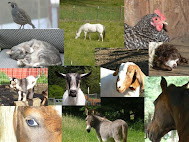Okay, what's up with buttemilk? Well, for one it's featured in such classic recipes as Buttermilk Biscuits, those wonderfully tender and flaky biscuits that we all crave at some point in time and Buttermilk Pancakes. Usually used in baking, buttermilk tends to produce what foodies would call a "tender crumb".
But where does it come from? Wikipedia describes it as a fermented dairy product. They identify two different processes whereby it is obtained. One is as the leftover product of producing butter. The milky liquid left behind is very low in fat, naturally acidic, and actually easier to digest than regular milk. The other is labeled cultured buttermilk and is the method whereby it is produced commercially. An acidic culture is added to 1%, 2% or even nonfat milk and the milk is allowed to "clabber" or thicken.
In our family, we go through stages of using buttermilk regularly, always in pancakes but also in scones, biscuits, and muffins. When we lived in town but I didn't get out much with the younger kids to shop as often, I would purchase a buttermilk powder to reconstitute with milk to use as buttermilk. It worked. Up until about a year ago, I would just grab a quart container off of the dairy shelf and call it good.
But all that was before we had dairy goats to milk and an abundance of wonderfully, fresh milk. That started my interest in what could be done with this milk. I found that buttermilk can be cultured at home so easily that it seemed silly to go out and purchase it any more.
Here's how it works:
Place one quart of milk, goat or whatever percent fat commerical milk you have on hand, in a clean sterilized quart jar. Leave about an inch headspace when filling the jar. To that add 1/2 cup buttermilk. This can be from a commercial batch as long as it is fresh and the label says cultured. Top off with a sterilized lid and give it all a good shake. Now this seems scary, but leave it on the counter at 70-86 degrees for 12 hours or so. As the acidic cultures begin to develop in the milk, it will become thick - noticeable so. If your kitchen is colder than 70 such as ours, it may take up to a day or two to thicken. Remove the lid and take a sniff. You should have that distinctive buttermilk smell. Success! Refrigerate and you're set.
Now here's the cool part. Never use up the last 1/2 cup of your buttermilk and start the process over each time. Of course, you need to be sure it doesn't actually sour on you and take on a spoiled smell. If so, you know what to do - throw it all away and start again. I know it seems a little startling and feels a little like you're about to eat a science experiment, but buttermilk has been cultured at home for centuries. We're just adding back one more piece of the self-sufficiency puzzle.
(Alternatively you can purchase packets of buttermilk culture from cheesemaking or dairy supply sources online.) www.cheesemaking.com
Saturday, February 7, 2009
Buttermilk
Labels: cooking, frugal living
Subscribe to:
Post Comments (Atom)


.jpg)







.JPG)





+(2).jpg)



0 comments - click here to leave your comments:
Post a Comment
I'd love to hear what you think, so leave me a message. Have a great day!